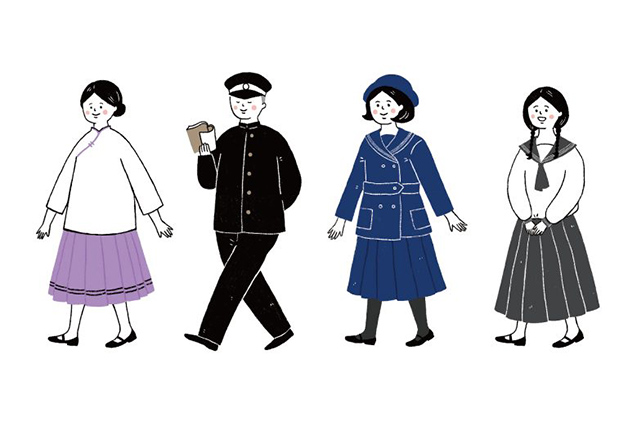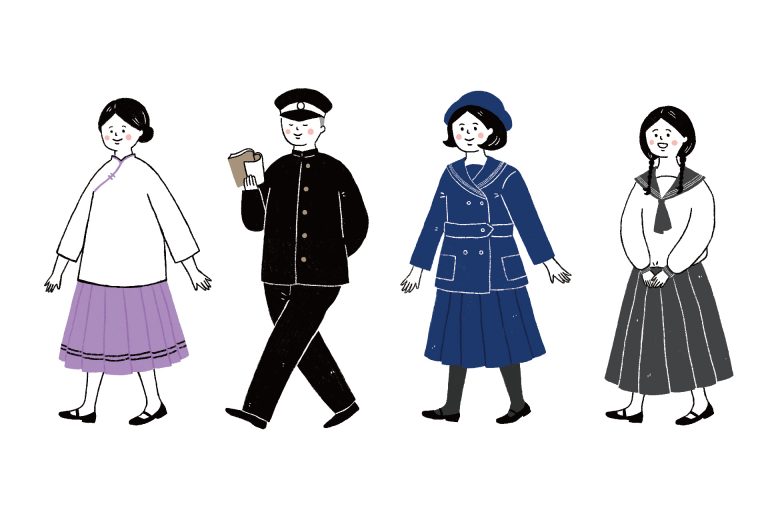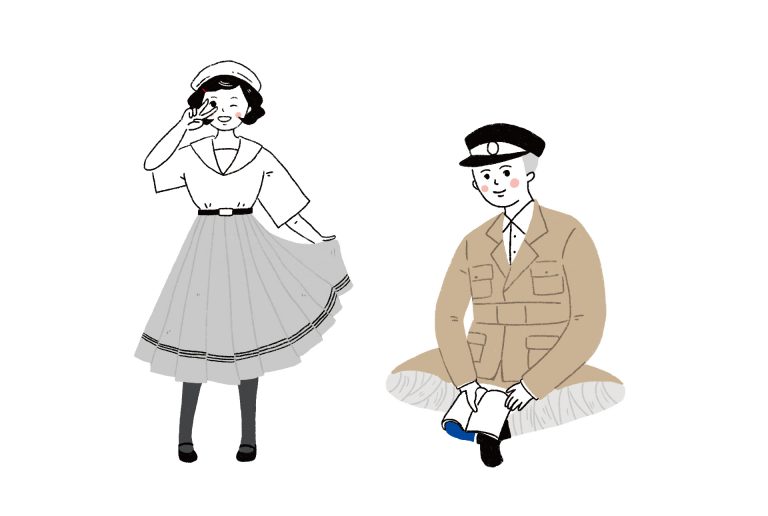School Uniforms in Japanese Colonial-Era Taiwan

Source:National Museum of Taiwan History
Did you know that Taiwanese high school students had to wear uniforms during Japanese colonial rule? The design of these school uniforms changed over time to reflect current social and political trends. Let’s take a look at some typical school uniforms of that period.
Views
School Uniforms in Japanese Colonial-Era Taiwan
By National Museum of Taiwan Historyweb only
The Emergence of Uniforms and their Evolution
Taiwanese novelist Chung Chao-cheng, who was born in 1925 and attended Tamsui Middle School (now New Taipei Tamkang High School), once mentioned that he felt an unforgettable pride each time when he paraded his school uniform in the streets of his hometown. That school uniforms became a source of pride and symbol of status is owed to the fact that Japan, which had governed Taiwan since 1895, introduced the school uniform system from Europe in the 1920s.
Before Taiwan came under Japanese control, Taiwanese children who were able to attend private study halls outside the home wore their everyday attire to class. In the early days of Japanese rule, when the colonizers still faced frequent armed resistance, formal Japanese education was still in its fledgling stage. With old habits hard to break, student clothing therefore continued to follow tradition.
In the 1920s, when Japan began to implement its assimilation policy, and Western clothing became popular in Taiwanese society, various mixed styles combining Chinese, Japanese and Western elements emerged.
As Western fashion became more common, the sailor suits worn by children in Europe became popular in Japan and also began to appear in Taiwan.
When the Sino-Japanese war broke out in 1937, school uniforms began to reflect the militarist spirit of the time.
 Illustrations from left to right:
Illustrations from left to right:
In the 1910s, girls at the Taihoku Prefectural Taihoku Third Girls’ High School wore a uniform that combined bluish purple hakama with a Chinese-style shirt.
In the 1920s, boys at middle and high schools wore a Western-style uniform with a band collar and a military-style pointed cap with the school crest.
In 1922, students at the Taihoku Prefectural Taihoku First Girls’ High School wore Western-style uniforms that paired a pleated shirt with a belted jacket and a hat, all in the same color.
After the 1920s, sailor-inspired uniforms gradually became the typical outfit for girls in high school. The white version was worn in the summer.
School Uniforms that Stood Out
Let’s take a look at some typical school uniforms to better understand their evolution in Taiwan during the Japanese colonial period.
Taihoku Prefectural Taihoku First Girls’ High School・Taipei First Girls’ High School
 Students at the Taipei First Girls’ High School wore short maroon hakama with their own personal kimono top.
Students at the Taipei First Girls’ High School wore short maroon hakama with their own personal kimono top.
The precursor of the Taipei First Girls’ High School was the Taihoku Prefectural Taihoku First Girls’ High School (hereafter called the First Girls’ High School). In its early days, the school, which was founded under a different name in 1904, mainly enrolled Japanese girls and originally did not require uniforms; the students attended school in traditional Japanese attire.
But in 1906, the school decreed that all girls were to wear a maroon hakama type that had been particularly designed for women. The girls were able to pair the hakama with their own kimono tops. In 1917, the maroon hakama became shorter, and the students were permitted to wear sports pants underneath. The outfits, which comprised a black winter season version and a white summer season version, were complemented by leather shoes.
By 1922, the school introduced a Western-style uniform with a white short-sleeved blouse that featured an aqua blue collar, sleeve bands and breast pocket. Three embroidered white stripes on the collar symbolized the school. The top was complemented by a 14-pleat aqua blue skirt, a white leather belt and a hat. In the winter, the girls wore a Prussian blue long-sleeved belted coat with a matching pleated shirt and hat in the same color. Their sports outfits consisted of a short-sleeved white shirt with black knickerbockers.
From 1933, the original short-sleeved white blouse became a sailor-style one with a Prussian blue collar. The pocket on the left was embroidered with the school emblem, and the collar still sported the three white stripes. This was paired with a pleated skirt and a white corduroy cap. In the winter, the girls wore a long Prussian blue coat and a round navy blue hat.
No. 1 Taihoku High School・Taipei Municipal Jianguo High School
After its founding in 1898, No. 1 Taihoku High School, today known as Taipei Municipal Jianguo High School, mainly enrolled Japanese students. When the high school section was spun off as a separate school in 1907, a band collar uniform was introduced, counting among the few early examples of school uniforms in Taiwan. In 1911, the students’ standardized outfits consisted of a cap, a school uniform, a work uniform, a coat, shoes and gaiters.
The black peaked cap featured an embroidered school crest on the band and three red stripes representing the school. It came with a white cloth cover that could be pulled over the black cap on hot days to protect against the heat. The uniform emulated Western band collar uniforms and came in white summer and black winter versions.
 Illustrations from left to right: A khaki uniform with a white turned-down collar shirt, black peaked cap, grey cloth gaiters and black leather shoes.
Illustrations from left to right: A khaki uniform with a white turned-down collar shirt, black peaked cap, grey cloth gaiters and black leather shoes.
After 1923, the Third Girls’ High School introduced new uniforms that were different from past uniforms in terms of tailoring and components.
Taihoku Third Girls’ High School・Taipei Municipal Zhongshan Girls’ High School
Taihoku Prefectural Taihoku Third Girls’ High School (hereafter called the Third Girls’ High School), which catered to Taiwanese girls, had no uniforms in the beginning. The students wore traditional Chinese clothes to school. In 1910, the school emulated the First Girls’ High School, adopting a bluish purple hakama with two black stripes combined with a traditional Chinese-style women’s top.
When the Office of the Taiwan Governor-General promulgated the Compulsory Education Guidelines in 1922, Japanese and Taiwanese children began to learn together. In response to the enrolment of Japanese students, rules on new uniforms were drawn up. All uniforms were Western style and were comprised of summer and winter outfits. Later on, a third black stripe was added to the original two black stripes on the white pleated skirts as a symbol for the Third Girls’ High School to prevent confusion with other girls’ schools.
After the 1920s, the Western sailor uniforms adopted in Taipei gradually became the rule at all girls’ high schools across Taiwan. Far into the 1940s, graduation photographs taken at the Third Girls’ High School still show students in sailor uniforms.
Have you read?
♦ Taiwan’s Best-funded Board Game Brings Wartime History Alive
♦ Tokyo’s Kabukicho - City of the Taiwanese
♦ How Rich Was Taiwan?
Rules on How and When to Wear Uniforms
Schools prescribed quite detailed standards regarding the fabric, style, and accessory size for school uniforms, and even provided illustrated examples to ensure that students had a clear understanding of these standards (back then, school uniforms were custom-made).
The uniform rules of the Affiliated College of Agriculture and Fishery at Taihoku Imperial University, today’s National Chung Hsing University, not only provided illustrations of shirt, jacket, trousers and cap but also gave detailed instructions regarding collar labels and button diameter.
Aside from regulating styles, schools also had specific rules as to when to wear uniforms.
The dress code called for uniforms to be worn not just during class but also for important school events, special functions and ceremonies or graduation trips. Some schools even required students to wear their uniforms during any outing, even if it took place after school or during holidays.
The national teachers’ association at the time had formed so-called off-campus disciplinary teams to monitor student behavior in public. Thanks to the uniform, a misbehaving student could be easily identified and reported to his or her school. As a result, students were always on the alert and took care not to overstep the line.
A former student at the Taihoku Prefectural Taihoku Second Girls’ High School (which was merged with the Taipei First Girls’ High School after the war) notes that she would be always very cautious when wearing her uniform during an outing for fear that her behavior could reflect badly on the school’s reputation.
 Schools usually issued detailed rules regarding uniforms. Since the school logo or badges made it easy to identify to which school a student belonged, students took care to behave well in public.
Schools usually issued detailed rules regarding uniforms. Since the school logo or badges made it easy to identify to which school a student belonged, students took care to behave well in public.
Dress Code Checks and Penalties
On the one hand, uniforms helped to project a school’s spirit and serve as its symbol, while also serving to rein in undesirable student behavior. Schools frequently checked whether uniforms complied with the school’s dress code and penalized students who were found wearing non-compliant attire or neglecting their appearance.
Taichung Middle School, now Taichung Municipal Taichung First Senior High School, for instance, had a “weekly duty education officer” comparable to a modern-day student counselor, whose job was to inspect students’ clothing and appearance. When students were found to have violated school rules, they were punished. Minor violations would lead to reprimands and scolding, whereas severe transgressions could lead to spanking and other forms of corporal punishment, and could even affect one’s grades for student conduct.
Covert Rebellion Against Uniform Dress Code
While most students behaved well and followed the dress code, some students were not so obedient. They quietly rebelled against the rules by modifying their uniforms in inconspicuous ways.
Taiwanese-American physician Y.C. Cheng, who attended Hsinchu Middle School during the Japanese era, said that his school stipulated that trousers must not have side pockets in order to prevent students from placing their hands in the pockets, which was considered rude. Yet some students disregarded this rule and asked their tailor to make pants with side pockets. When the time came for uniform checks, they simply sewed them shut to prevent detection.
Typical dress code violations were overlong shirt hems and sleeves, upturned shirt collars, pants in non-compliant colors, or skirts that were too short or did not have the prescribed number of pleats. Other offenses were covering the school logo on the band of the peaked cap, wearing a non-compliant cap, or wearing traditional Japanese wooden clogs or high heels.
Student uniforms evolved over time in response to various internal and external factors. In Taiwan, the development went from laissez-faire to strict regulation, from mixed Chinese-Japanese styles to Western-inspired uniforms. Even today, traces of this historic legacy can still be discovered in the style of some school uniforms.
(Article from I Don’t Want to Go to School, volume 39 of periodical Watch Taiwan published by National Museum of Taiwan History)
Written by Peng Wei-hsiang
Illustration by Fang An
Translated by Susanne Ganz
Edited by Sharon Tseng








